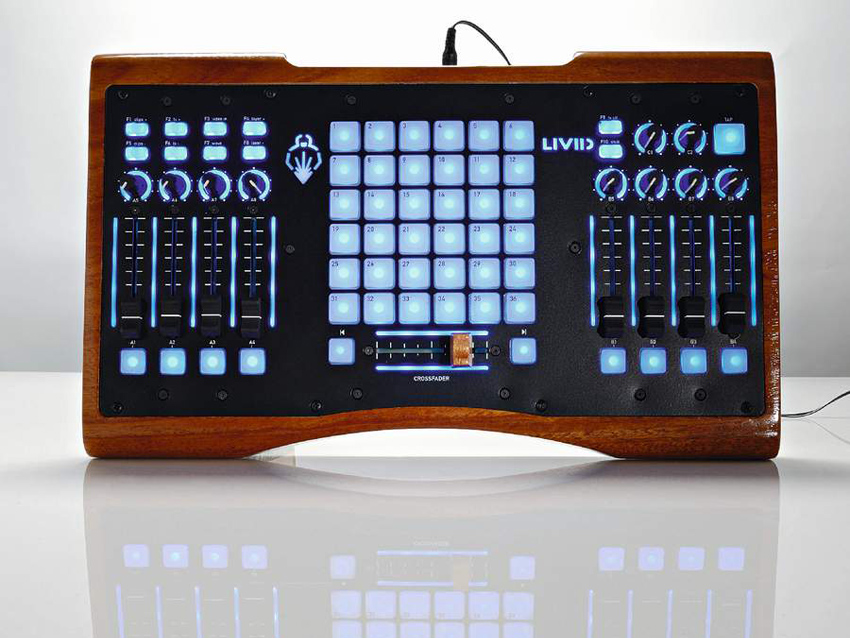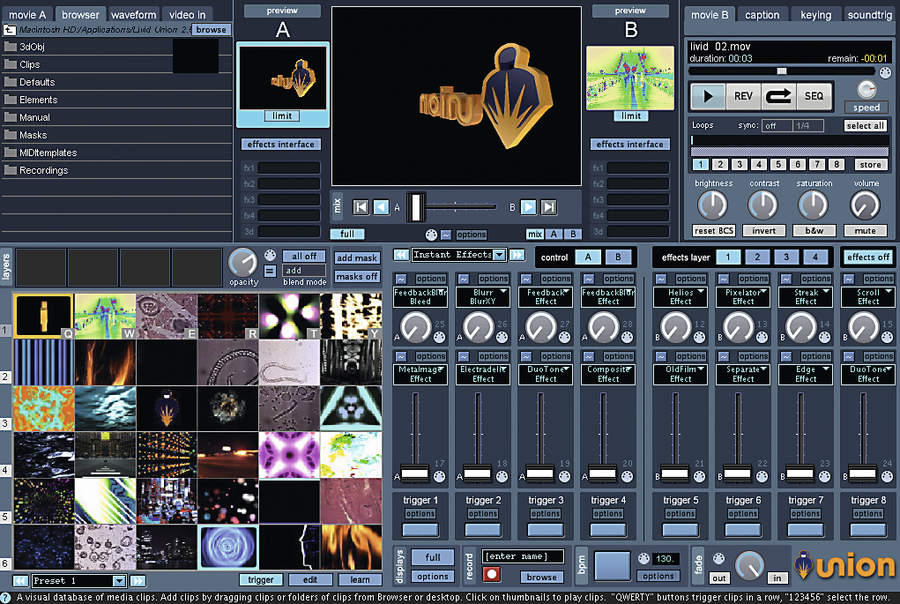MusicRadar Verdict
An amazing looking unit that, with a software update or two, could have a very bright future.
Pros
- +
Incredibly flexible. Pads are great for triggering samples or events. Channel faders and mute/solo buttons are very useful.
Cons
- -
Inverted crossfader in Ableton Live. Can't edit the MIDI map or channel outputs.
MusicRadar's got your back


When it comes to performing live, electronic music has always been on the back foot. In fact, many of the big name electronic acts have simply resorted to DJ sets when playing live rather than recreating the studio setup.
With the development of Ableton Live and similar software, though, and the shrinking in size and price of powerful laptops, more and more acts are jumping in at the deep end and taking their show on the road.
This has led to the development of a new generation of MIDI controllers - hardware that´s designed to maximise the new possibilities open to today´s electronic performer.
Up until now, Livid Instruments has focused more on VJing and the more experimental elements of live music, but with the release of its new Ohm controller, things are about to change for the small Texan company. While it´s still aiming to attract VJs (Livid´s own VJ software, Union, is bundled with the unit), the magic of MIDI means we can hook it up to any software that supports mapping, or any hardware with MIDI capabilities.
Couple this with the extreme versatility of the Ohm´s impressive interface and it´s difficult to understate the potential impact of this beautifully made controller.
Overview
The Ohm comes in two impressive cases: the Ohm Wood, which we´re testing here, and the Ohm Metal, a rack-mountable, steel-cased version. The unit is reassuringly heavy and you immediately understand why its price is relatively high.
Setting up the Ohm is straightforward, and we had the impressive backlit LEDs brightening the room in less than five minutes. The Ohm requires a separate 12v AC adaptor, which is included, as well as a USB connection if you´re using it with your computer.
It´s a shame it isn´t buss-powered, but given the amount of controls and its size, we can forgive this.
When you first start sliding the faders and turning the rotaries, you can really feel the subtle nuances that Livid has added to the unit to give it a very professional feel. Few MIDI controllers are as gratifying to use.
The fader knobs are coated in a comfortable rubber, and slide gracefully and satisfyingly. The rotaries are of a similar style, turning with just the right amount of stiffness and having a really authoritative feel.
The pads are raised slightly above the casing, and as your fingers bounce from one to the next you get the feeling they´re suitable for both MPC-style drum bashing and one-shot sample triggering.
Finally, there´s the wood-coated crossfader - it´s a tad stiffer than most other MIDI examples, but this isn´t really an issue and it fits in with the general high-quality feel of the unit.
In use
When you´ve finished being dazzled by the look and feel of the unit, it´s time to get to work. We tested it with Ableton Live, and what excited us the most was the potential to trigger 36 clips via the pads.
We set up six channels and mapped each button to its relative clip and the faders to their relative channel (using one of the extra faders for Send volume, and the final one for Master volume). After some initial MIDI clock setup issues, the Ohm worked like a treat - almost.
The one problem we had in Ableton Live was that the Ohm´s crossfader was inverted. If this happened on any other MIDI controller, you´d be pretty disappointed but would find a way around it, or use other software. However, as the Ohm is so ideal suited to Live´s interface and functions, it´s a massive blow to fans of the software.
So, what´s the solution? Invert your crossfader track assignments? Use another piece of kit just for the crossfader? Or simply just get used to the flaw? We´re sure Livid will address the issue in a future update, but as things stand, it´s an annoying fly in the ointment.
Another issue, which no doubt will also be addressed in the future, is the inability to edit the MIDI map and channel outputs. Although this is fairly restricting, it´s not all that troublesome unless, again, you´re using the unit in Ableton Live.
Live´s bundled drum sampler, Impulse, has fixed trigger pads that run from C3 to C4. As none of the 36 pads on the Ohm correspond to these note values, the unit is unusable with Impulse. You can, however, use it with Live 7´s Drum Racks, but anyone with an older version of the software will either have to upgrade, or use the pads solely for clip triggering. That said, it is worth noting that there´s no velocity variation on the pads - it´s limited to 0 or 127 (ie, off or on).
Summary
Despite the issues above, our general impression of the Ohm is that it works well and feels great. And there´s no denying that it´s a beautiful, well-made piece of kit.
What´s more, there seems little doubt that the Ohm will be improved with software upgrades. As these start to roll out, we´re confident that Livid´s controller will start to be seen on more and more stages around the world.
MusicRadar is the number 1 website for music makers of all kinds, be they guitarists, drummers, keyboard players, djs or producers...
GEAR: We help musicians find the best gear with top-ranking gear round-ups and high- quality, authoritative reviews by a wide team of highly experienced experts.
TIPS: We also provide tuition, from bite-sized tips to advanced work-outs and guidance from recognised musicians and stars.
STARS: We talk to musicians and stars about their creative processes, and the nuts and bolts of their gear and technique. We give fans an insight into the actual craft of music making that no other music website can.
“A synthesizer that is both easy to use and fun to play whilst maintaining a decent degree of programming depth and flexibility”: PWM Mantis review
“I feel like that song had everything we needed to come back with”: Bring Me The Horizon’s Lee Malia on Shadow Moses, its riff and the secrets behind its tone, and why it was the right anthem at the right time
“I said, ‘Are we sure we can write a song about death?’”: The story of Mike + The Mechanics' classic No.1 The Living Years










